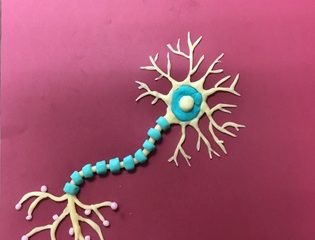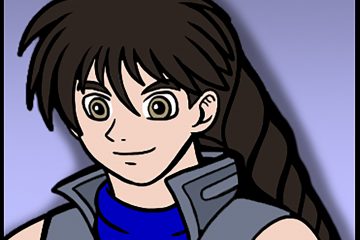
the 12th was Roger and my 42nd wedding anniversary! Here we are in 1974 ( married 2 years) dressed very 70’s California.
- Here is what I am reading today:
“Dizzy and nauseated? You could be dehydrated or have high blood pressure—or there could be a giant hole in your brain. After a 24-year-old woman complained of these symptoms at a hospital in China, doctors scanned her brain anddiscovered that her cerebellum was missing, a new study in Brain reports. Despite missing the entire region, which helps control movement, balance, and speaking, the woman displays only mild clumsiness and slightly slurred speech—a remarkable example of the brain’s ability to compensate, New Scientist reports today.”
“”Our aim was to investigate what is going on in the brains of people when they watch violent movies,” said lead investigator Nelly Alia-Klein, PhD, Associate Professor of Neuroscience and Psychiatry at the Friedman Brain Institute and Icahn School of Medicine at Mount Sinai. “We hypothesized that if people have aggressive traits to begin with, they will process violent media in a very different way as compared to non-aggressive people, a theory supported by these findings.””
“Taski found that the mechanical pulse was modified at the collision point, but he did not completely examine the details of annhilation itself. Apparently, no other studies have replicated the original 1949 experiments. Falsification of the annhilation scenario really only requires showing sufficient exception, enough that there no longer is a “general case”. Thomas Heimburg, from the Neils Bohr Institute in Copenhangen, has recently been able to do just that. Using a simple worm axon preparation where spikes could be timed and measured after stimulation from both ends, Heimburg showed that pulses survive collision.”
“Researchers Jose Fernandez and Dhaval Dave analyzed the number and wages of auxiliary health providers based on California Department of Developmental Services data from 2002 to 2011. Each time autism cases doubled, the number of autism health providers grew by as much as 14 percent over that of non-autism health providers, they found.”
“The Stonehenge Hidden Landscapes Project, led by the University of Birmingham in conjunction with the Ludwig Boltzmann Institute for Archaeological Prospection and Virtual Archaeology, is the largest project of its kind.”
“”Responding sensitively to infant crying is a difficult yet important task,” notes Esther M. Leerkes, professor of human development and family studies at the University of North Carolina at Greensboro, who led the study. “Some mothers may need help controlling their own distress and interpreting babies’ crying as an attempt to communicate need or discomfort. Home visiting programs or parenting classes that help parents become more aware of stress and teach ways to reduce it, as well as individualized parent education efforts, may help build these skills.””
“Results show that past use of benzodiazepines for three months or more was associated with an increased risk (up to 51%) of Alzheimer’s disease. The strength of association increased with longer exposure and with use of long-acting benzodiazepines rather than short-acting ones.
Further adjustment for symptoms that might indicate the start of dementia, such as anxiety, depression or sleep disorders, did not meaningfully alter the results.”
“Dr Robert Dickinson from the Department of Surgery and Cancer at Imperial College London, who led the study, said: “After a blow to the head, most of the damage to the brain doesn’t occur immediately but in the hours and days afterwards. At present we have no specific drugs to limit the spread of the secondary injury, but we think that is the key to successful treatment.
“This study shows that xenon can prevent brain damage and disability in mice, and crucially it’s effective when given up to at least three hours after the injury. It’s feasible that someone who hits their head in an accident could be treated in the hospital or in an ambulance in this timeframe.”
“Led by Ifat Levy, assistant professor in comparative medicine and neurobiology at Yale School of Medicine, the team found that those with larger volume in a particular part of the parietal cortex were willing to take more risks than those with less volume in this part of the brain. The findings are published in the Sept. 10 issue of the Journal of Neuroscience.”
““If you ask any psychiatrist seeing patients with autistic behavior their most striking observation from the clinic, they will say there are more males compared to females,” said Dr. Anilkumar Pillai, MCG neuroscientist and corresponding author of the study in Molecular Autism.”



4 Comments
aflor · October 4, 2014 at 7:44 pm
The article that I read was “Xenon Gas Protects the Brain After Head Injury.” This was very interesting because after several studies done on mice, it has been found that treatment of xenon gas for a head injury can reduce the extent of brain damage. Xenon can also be given at least three hours after the head injury, and it would still be effective. This really amazes me to see how far we have gone in the use of medicine. I am curious to see data behind any side effects it might cause. Or are they unknown? I would also like to find an article that gives me more information on how xenon is used to treat babies who experienced oxygen deprivation during birth.
madelyne.spivek · October 20, 2014 at 10:38 pm
I found the Violent Media article really interesting because it reminded me of the study we look at of the comparison of a normal brain to a psychopath brain. I think most people would expect the psychopath brain to light up when shown emotional words, but instead they processed these words exactly as one would process neutral words. So just as a psychopath processes emotional words and neutral words the same, those with aggressive traits in the study had very little brain activity when it would be presumed that they would.
emmathompson95 · October 23, 2014 at 12:07 pm
I thought that the Violent Media article would be a very good subject to include in the next revision of your book, because it is very relatable to college students. I think that a vast majority of college students, especially males, either play violent video games or watch violent TV shows/movies. I think that the students who read your book will find this interesting.
aflor · November 17, 2014 at 9:53 pm
The article that I found interesting to read was “Mothers’ responses to babies’ crying: Benefiting from and getting over childhood experiences.” I think the research found in this study really highlights the importance of mother and infant relationship. Sometimes as mothers, one is unable to fully understand the signs that their infant is trying to give them. It can cause difficulties for the baby if certain needs aren’t being met. I think more classes similar to the one’s discussed in the article, need to be created in order to help mother’s cope with stress. I can only imagine that being a mother is both rewarding but stressful at the same time. If a mother isn’t able to cope, then she will be unable to focus on her infant. I also found it interesting that the process of how a mother promotes sensitivity to distress is universal.